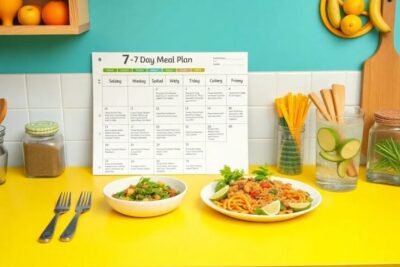
Diabetic Friendly Food Options: A Comprehensive Guide to Eating Healthily
- Introduction to Diabetes Management
- Understanding Carbohydrates and Their Impact
- Exploring Diabetic-Friendly Food Choices
- Signature Beverages for Diabetic Wellness
- Navigating Snack Options Wisely
- Mindful Eating Practices for Diabetics
- Meal Planning Strategies for Diabetes
- The Role of Support and Community
- Conclusion: Taking Charge of Your Health
Introduction to Diabetes Management
The management of diabetes is a multifaceted process that primarily involves diet, exercise, and medication. Diet plays a particularly crucial role in maintaining normal blood sugar levels and supporting overall health. Food choices are vital not only for managing diabetes but also for minimizing the risk of complications associated with the disease. This includes selecting diabetic-friendly foods that can help balance blood sugar levels while providing essential nutrients.
In the context of diabetes, understanding the concept of diabetic-friendly foods is essential. These are often foods that have a low glycemic index (GI) and are high in fiber, which enables them to be digested slowly and prevents rapid spikes in blood sugar. Incorporating such options can offer a strategic benefit for individuals looking to enhance their diet without compromising their health. A variety of establishments, such as Starbucks, offer diabetic-friendly food choices that patrons can enjoy while adhering to their dietary needs.
Moreover, creating a meal plan that emphasizes balance and moderation is imperative. This means that instead of completely restricting certain food groups, individuals should focus on the right portion sizes and combinations. For example, whole grains, lean proteins, healthy fats, and vegetables can all be part of a delicious and diabetic-friendly meal. In settings such as Starbucks, planning can extend to snack options as well, enabling those with diabetes to make informed selections while on the go.
This foundational understanding provides the groundwork for recognizing how food choices directly influence diabetes management. By choosing the right diabetic-friendly food at locations like Starbucks, individuals can enjoy their favorites and maintain their health, leading to an improved quality of life.
Understanding Carbohydrates and Their Impact
Carbohydrates play a crucial role in a balanced diet, serving as a primary source of energy. However, for individuals with diabetes, understanding the distinction between simple and complex carbohydrates is essential in managing blood sugar levels effectively. Simple carbohydrates, often found in sugary snacks and beverages, are quickly digested and can lead to rapid spikes in blood glucose. Examples include table sugar, honey, and fruit juices. Conversely, complex carbohydrates, which are found in whole grains, legumes, and vegetables, take longer to break down, resulting in a more gradual increase in blood sugar.
The glycemic index (GI) is an important tool that categorizes carbohydrates based on their impact on blood sugar levels. Foods with a high GI are rapidly absorbed and can elevate blood sugar levels quickly, while low-GI foods are digested more slowly, leading to a more sustained energy release. For those exploring diabetic-friendly food options, it's advisable to prioritize low-GI foods. These often include whole grain breads, peas, and a variety of fruits and vegetables. By focusing on low-GI complex carbohydrates, individuals with diabetes can maintain more stable glucose levels, reducing the risk of severe fluctuations that can lead to health complications.
When considering places like Starbucks for diabetic-friendly food options, it is important to evaluate the carbohydrate content of menu items carefully. Many drinks and snacks incorporate refined sugars, making their carbohydrate content less favorable for those managing diabetes. Opting for items with lower sugar and carbohydrate content can help in making informed choices that align with a diabetic-friendly diet. By understanding the nature of carbohydrates and their effects on blood sugar, individuals can better navigate their food choices and lead a healthier lifestyle.
Exploring Diabetic-Friendly Food Choices
For individuals navigating life with diabetes, making informed choices about food is paramount. A well-rounded diet can significantly aid in maintaining stable blood sugar levels and overall health. This section will delve into various options that fit within the realm of diabetic-friendly food choices, including fruits, vegetables, whole grains, lean proteins, and healthy fats.
Fruits such as berries, apples, and pears are excellent choices due to their lower glycemic index and fiber content, which can help regulate blood sugar levels. Incorporating these fruits into meals or snacks can provide essential vitamins without causing sharp glucose spikes. Similarly, non-starchy vegetables like spinach, broccoli, and bell peppers offer valuable nutrients while being low in calories and carbohydrates, making them ideal for those monitoring their carbohydrate intake.
Whole grains are another crucial component of a diabetic-friendly diet. Options like quinoa, brown rice, and whole grain breads not only provide fiber but also help in managing blood sugar levels. These foods break down more slowly in the body compared to refined grains, allowing for a gradual rise in glucose levels. It is also essential to consider portion control when consuming carbohydrates, as even healthy options can contribute to excess calorie intake when not measured appropriately.
Lean proteins such as chicken, fish, beans, and legumes can be part of a balanced meal plan, promoting muscle health and providing long-lasting energy. Healthy fats from sources like avocados, nuts, and seeds are also beneficial, as they can improve heart health and assist in the absorption of fat-soluble vitamins without adversely affecting blood sugar levels. Balancing these food groups with an emphasis on portion sizes enables individuals to enjoy a wide array of flavorful diabetic-friendly food choices, ultimately creating a nutritious and fulfilling diet.
Signature Beverages for Diabetic Wellness
Individuals managing diabetes often face challenges when it comes to choosing suitable beverages. It is essential to select options that do not adversely affect blood sugar levels. When considering diabetic friendly food Starbucks offers, there are various drinks that can support wellness while keeping sugar intake in check.
Among these, cold brew coffee is a stellar choice. This beverage is brewed over an extended period using cold water, resulting in a refreshing drink with a smoother taste and lower acidity. For those who prefer a sweeter flavor without the excess calories, a splash of unsweetened almond milk or a sprinkle of cinnamon can be added for a delightful twist without significantly affecting blood sugar.
Another commendable option is herbal teas. They come in various flavors and offer numerous health benefits. Herbal teas, such as chamomile or peppermint, contain no calories and are naturally caffeine-free, making them a great companion during any time of the day. They not only refresh but can also aid in digestion and overall wellness, which is vital in maintaining balanced blood sugar levels.
For those seeking beverages outside the coffee realm, infused water is a delightful alternative. Adding slices of cucumber, lemon, or berries to a pitcher of water not only enhances flavor but also provides hydration without the added sugars typically found in traditional soft drinks. Such options align well with a diabetic friendly food approach while delivering essential vitamins and antioxidants.
Incorporating these beverages into your daily routine can promote a healthy lifestyle for individuals managing diabetes. By choosing low-sugar and low-calorie options available at coffee shops and cafes, individuals can enjoy refreshment without compromising their health. This careful selection ultimately supports better blood sugar regulation and contributes positively to overall well-being.
When managing diabetes, it is essential to choose snacks that provide nourishment without causing harmful spikes in blood sugar levels. One effective strategy for maintaining stable energy levels is to select diabetic-friendly food options, particularly when on-the-go or frequenting establishments like Starbucks. These snacks should ideally be low in sugar and rich in fiber, protein, or healthy fats, which contribute to satiety and overall well-being.
Nut-based snacks are a prime choice, offering heart-healthy fats combined with protein. Almonds, walnuts, or pistachios can be consumed in moderation, ensuring a satisfying crunch while helping to regulate blood sugar levels. Alternatively, a small serving of plain Greek yogurt can serve as an excellent snack due to its high protein content. Pairing it with a few fresh berries not only enhances flavor but also introduces essential antioxidants without excessive sugar.
Vegetable-based snacks are another viable option. Carrot sticks, cucumber slices, and bell peppers can be enjoyed raw or with a low-calorie dip such as hummus. These choices are low in calories and high in nutrients, supporting a healthy lifestyle for individuals managing diabetes. Furthermore, whole-grain crackers or rice cakes, when paired with a lean protein source like turkey slices or soft cheese, provide a balanced snack that can sustain energy levels.
For those at Starbucks seeking diabetic-friendly food options, consider requesting snacks that come with added protein or fiber, such as their protein boxes. Additionally, choosing unsweetened beverages or those that use sugar alternatives can help in making better snack choices while enjoying your coffee break. By carefully navigating snack options, individuals with diabetes can maintain their health goals without sacrificing taste or satisfaction.
Mindful Eating Practices for Diabetics
Mindful eating is an approach that encourages individuals to focus on their food, allowing them to cultivate a greater awareness of the eating experience. For those with diabetes, adopting mindful eating practices can be particularly beneficial as it helps manage blood sugar levels and promote overall well-being. By slowing down and participating in the process of eating, individuals can develop a deeper understanding of not only what they are consuming but also how it affects their body.
A fundamental principle of mindful eating is to slow down during meals. This can be achieved by taking smaller bites, chewing food thoroughly, and savoring each flavor. By doing so, individuals with diabetes can better realize when they are satisfied and reduce the chances of overeating. Studies indicate that eating slowly allows the brain to process signals of fullness, potentially leading to healthier portion sizes and improved management of diabetic friendly food choices.
Recognizing hunger cues is another essential component of mindful eating. Individuals with diabetes can benefit from differentiating between physical hunger and emotional cravings. Keeping a food diary may enhance awareness and foster better decision-making regarding food intake. By paying attention to one’s internal signals, it becomes easier to make intentional food choices that align with health goals. For instance, when considering a visit to Starbucks, individuals can opt for diabetic friendly food options, focusing on whole grains or protein-infused snacks that align with their dietary requirements.
Intentional food choices also extend to meal planning and preparation. Being proactive about food selections can not only alleviate the stress of last-minute decisions but also ensure that diabetic friendly foods are readily available. Overall, integrating mindful eating practices into daily routines can significantly enhance the eating experience for individuals with diabetes, supporting better health outcomes.
Meal Planning Strategies for Diabetes
Managing diabetes effectively often begins with proper meal planning. This involves the deliberate creation of balanced meals that incorporate essential nutrients while keeping blood sugar levels stable. A fundamental strategy is understanding the importance of carbohydrates, proteins, and healthy fats. Carbohydrates, for instance, significantly influence blood sugar levels, so it is crucial to choose high-fiber options such as whole grains, legumes, and vegetables. Pairing these with lean proteins and healthy fats can help mitigate blood sugar spikes.
Prepping meals in advance can also prove instrumental in managing diabetes. By dedicating time each week to prepare diabetic-friendly food options from venues such as Starbucks or at home, individuals can streamline their daily routines and mitigate the risk of impulsive, less healthy eating. Preparation might involve cooking batches of suitable grains, roasting vegetables, or portioning out snacks that align with a diabetic nutrition plan. Having readily available meals that fit within dietary requirements not only supports better blood sugar management but also lessens the stress associated with last-minute food choices.
Additionally, incorporating diabetic-friendly recipes into meal planning can enhance the variety and enjoyment of food without compromising health. Many resources provide easy-to-follow recipes that focus on low glycemic index ingredients, ensuring that meals contribute to overall wellness rather than hinder it. With the right planning, individuals can enjoy balanced and satisfying meals, including options that may be available at popular establishments like Starbucks, fostering a lifestyle conducive to diabetes management.
By embracing these meal planning strategies, individuals can cultivate a structured approach to their dietary needs, ultimately leading to improved control over blood sugar levels and a healthier lifestyle.
The Role of Support and Community
Managing diabetes can often feel like an uphill battle, particularly when it comes to dietary choices and maintaining a healthy lifestyle. One of the most significant factors in successfully navigating this journey is the presence of a supportive community. Engaging with individuals who share similar experiences can lead to increased motivation and encourage healthier habits, such as integrating diabetic friendly food options at popular establishments like Starbucks.
Building a support network—whether through local diabetes support groups, online forums, or social media communities—provides individuals with a platform to share experiences, tips, and strategies. These interactions can lead to not only emotional support but also practical advice on meal planning, shopping tips, and making informed decisions about what to order when eating out. Communities focused on diabetes management can offer insight into choices that allow for enjoyment without compromising health, including recommendations for diabetic friendly food at Starbucks.
Furthermore, sharing personal stories can be incredibly empowering. Individuals can feel less isolated in their struggle, and by voicing challenges and successes, they can inspire others facing similar obstacles. Many online platforms also feature expert contributions, providing access to professional guidance on proper nutrition, exercise, and effective management strategies. This blend of peer support and expert advice can significantly enhance one's ability to stay committed to a diabetic-friendly lifestyle.
In conclusion, cultivating a robust support system is fundamental for anyone managing diabetes. By connecting with others and sharing experiences, individuals can not only gain valuable resources and advice but also foster lasting motivation to adhere to a healthy and balanced diet that includes diabetic friendly food options from various sources, including well-known coffee shops such as Starbucks.
Conclusion: Taking Charge of Your Health
In the realm of diabetes management, the choices we make about our diet hold significant power. Opting for diabetic friendly food options at places like Starbucks can illustrate how convenience can align with health needs. By selecting menu items that cater to diabetic requirements, individuals can enjoy their meals without compromising their health.
Utilizing the knowledge from this comprehensive guide empowers readers to make informed dietary decisions. It is essential to recognize that eating well is not merely about restriction but about embracing a variety of foods that nourish the body while still allowing for enjoyment in dining experiences. Educating oneself on nutritional content and being aware of glycemic indexes can lead to healthier choices. Starbucks, for instance, offers several options that contain lower sugars and healthier fats, making them suitable for those managing diabetes.
The journey toward better health does not have to be undertaken alone. Numerous resources, including nutritionists and diabetes education programs, can provide support. Furthermore, engaging with local communities or online forums dedicated to health can enhance one’s understanding and implementation of diabetic friendly food options. It is crucial for individuals with diabetes to advocate for their needs, ask questions, and seek out beneficial food alternatives. As such, frequenting establishments like Starbucks can yield a variety of choices that meet dietary restrictions without sacrificing taste or satisfaction.
In conclusion, taking charge of your health requires a commitment to making educated decisions regarding food. By applying the insights gained about diabetic friendly options, individuals can navigate dining situations with confidence, leading to improved health outcomes and a fulfilling lifestyle. Remember that every meal is an opportunity to support your health journey positively.










